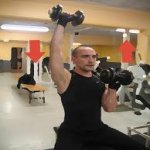Upper trapezius activation increases during high-speed activities or when fatigue is increased.
A new study examined 46 subjects with EMG devices to record muscle activation while raising the arm overhead. When the movement was performed at a low speed, the preferred muscle recruitment pattern was first middle trapezius, then lower trapezius, then serratus anterior, then anterior deltoid, and lastly upper trapezius.
In the high-velocity group, however, the upper trapezius became increasingly active as the participants fatigued. As fatigue persisted, the upper trapezius became the most prominent contributor to the movement.
Implications
This study demonstrates that as the body fatigues, the nervous system will adopt a more “global” approach and recruit the larger muscles (such as upper trapezius) in place of some of the smaller, “local” muscles (such as lower trapezius). This tendency towards a more “global pattern” may contribute to why so many individuals experience chronic discomfort in the upper trapezius region.
The study also highlights the role that velocity plays in muscle recruitment. For coaches or clinicians who are trying to teach clients to engage particular muscles without unfavorable compensations, low-speed movements or isometric drills appear favorable compared to high-velocity exercises.
References
